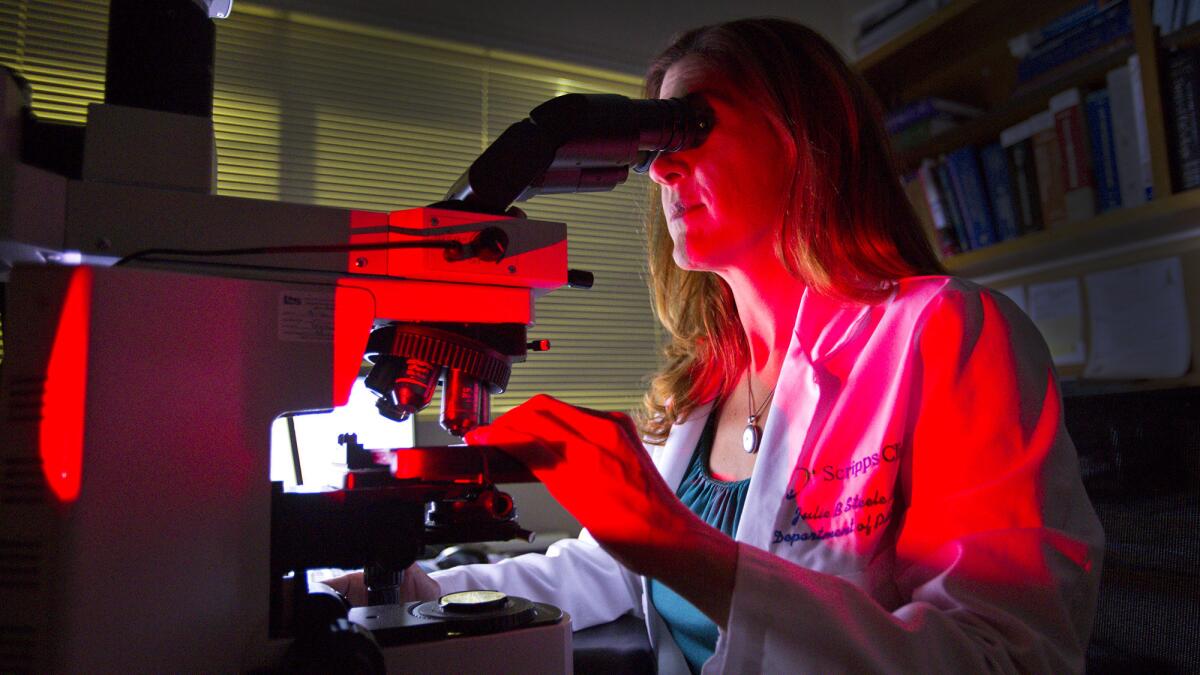San Diego’s Scripps Health partners with MD Anderson to expand cancer network’s reach

In a bid to increase its reach throughout Southern California, the San Diego-based Scripps Health system on Monday finalized a partnership with the internationally known MD Anderson Cancer Network.
The deal makes Scripps the only direct collaborator with Houston-based MD Anderson in an eight-county region stretching from the U.S.-Mexico border north through Santa Barbara County and east to California’s border with Arizona.
Executives from both organizations gathered for a contract-signing ceremony in La Jolla, making official a relationship that has been building since MD Anderson approached Scripps in May 2015.
The new partners said they will immediately begin recruiting physicians, including a new program director. Scripps said it will adopt MD Anderson’s treatment protocols and overall standards of cancer care. The two organizations plan to share tumor boards — groups of oncology specialists who collectively discuss patients’ cases. And Scripps will have access to more than 1,100 clinical trials — a program that MD Anderson bills as the largest collection of active cancer research in the nation.
“Our goal is to build our program up so it is as good as any other cancer program in the country,” said Chris Van Gorder, Scripps Health chief executive.
Scripps is one of five health providers in the nation to join the the Houston-based network as full partner.
Amy Hay, vice president for business development at MD Anderson, said full partnerships are infrequent because they require the challenging task of replicating the network’s quality and operations standards in satellite locations.
“The integration is around our clinical care and research programs, and physician partners sometimes become adjunct professors at MD Anderson,” Hay said.
She also said MD Anderson takes a holistic approach to every patients’ cancer care: Each person meets with a comprehensive, multidisciplinary team from the outset to come up with a personalized treatment plan.
“That means you would have a medical doctor, oncology radiologist, oncology surgeon, experts in diagnostic imaging, pathology, pharmacy and nursing … it’s a team approach to evaluating that patient and making consensus agreements about treatment,” Hay said.
Van Gorder said MD Anderson spent months examining Scripps’ existing cancer operations before deciding to forge a deal, which involves the privately run Scripps paying a participation fee that it has declined to disclose.
One key principle is fully embracing the changing nature of cancer care, Van Gorder said. Because of its size and number of researchers, he said, MD Anderson has the opportunity to constantly change its standard of care as new scientific concepts, drugs and other therapies are validated.
“We have a good program, but the body of knowledge is medicine is growing so fast that it’s almost impossible for any one physician to keep up with. What we feel is, since the body of knowledge is changing so fast, the best way our doctors can do that is to be part of MD Anderson,” Van Gorder said.
News of a potential partnership between MD Anderson and Scripps became public in mid-July, and drew immediate concerns from top leadership at UC San Diego, which runs the Moores Cancer Center in La Jolla.
Moores is the region’s only comprehensive cancer center as designated by the National Cancer Institute, or NCI. Anderson also is an NCI designee, one of 47 nationwide. NCI centers are expected to conduct innovative research and provide integrated care for their patients that goes beyond what would be found at most hospitals.
While Anderson’s main facility in Houston has this designation, the new Scripps center will not be directly certified.
In July, UC San Diego executives expressed concern that patients might think they were going to an NCI-level facility the moment MD Anderson’s name appears beside Scripps’ even though it could take many years to reach that level. And they worried about patients being transferred to clinical trials in Houston even if similar studies are available at Moores.
Van Gorder said he expects the changes called for in the partnership to occur quickly.
“It won’t happen overnight, that’s true,” Van Gorder said, “but it’s not going to take years.”
As to Scripps’ participation in clinical trials, Hay said Anderson intends to offer many of its trials in the Southern California market through Scripps facilities. However, Hay and Van Gorder said it is not likely that all of Anderson’s trials can be replicated locally.
Sisson writes for the San Diego Union-Tribune.






